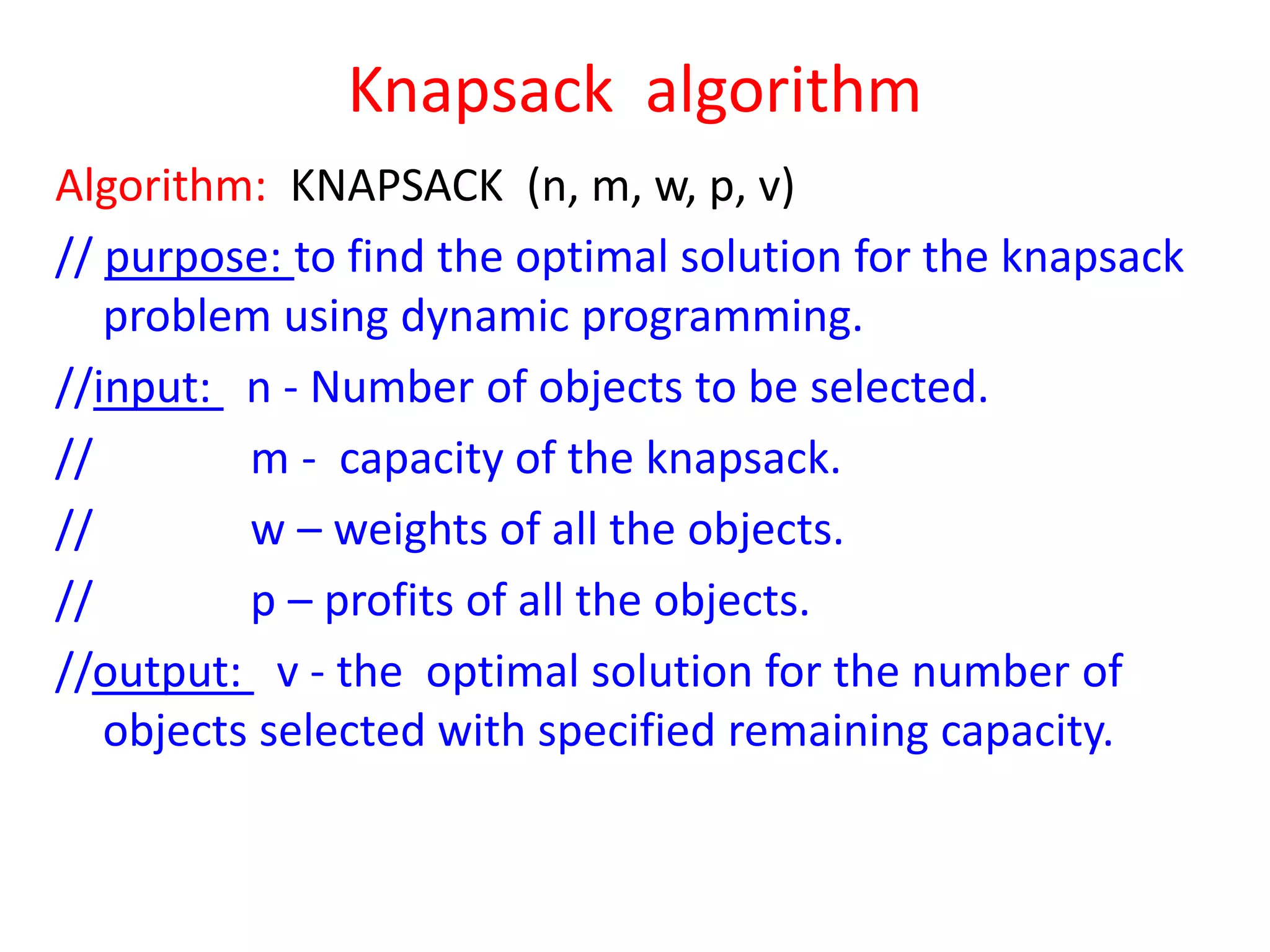The document contains pseudocode for 4 algorithms:
1) Binomial coefficient algorithm to compute binomial coefficients using dynamic programming.
2) Warshall's algorithm to find the transitive closure of a graph by computing the path matrix between all pairs of vertices.
3) Floyd's algorithm to find all pairs shortest paths in a weighted graph using dynamic programming.
4) Knapsack algorithm to find the optimal solution to the knapsack problem using dynamic programming.

![Algorithm: Binomial_coefficient(n , k)
// purpose: to compute binomial by dynamic programming
//input: non negative integers such as n ≥ k ≥ 0
//output: value of nCk also designated as C(n,k)
for i = 0 to n do
for j = 0 to min(I,k) do
if(j=0 or i = j)
c[i,j] = 1
else
c[i,j] = c[i-1 , j-1] + c[i-1 , j]
end if
end for
end for
Return c[n,k]](https://image.slidesharecdn.com/dynamicprogrammingproblems-131218221427-phpapp01/75/Dynamic-Program-Problems-2-2048.jpg)
![Warshall’s algorithm
Algorithm: warshall(n, A, p)
// purpose: to compute transitive closure(path matrix)
//input: adjacency matrix A of size n x n
//output: transitive closure(path matrix) of size n x n
Step1: // make a copy of adjacency matrix
for i=0 to n-1 do
for j = 0 to n-1 do
p[i,j] = A[i,j]
end for
end for](https://image.slidesharecdn.com/dynamicprogrammingproblems-131218221427-phpapp01/75/Dynamic-Program-Problems-3-2048.jpg)
![Step2: // find the transitive closure(path matrix)
for k =0 to n-1 do
for i=0 to n-1 do
for j=0 to n-1 do
if(p[i,j]=0 and (if(p[i,k] =1 and p[k,j] =1)) then
p[i,j]=1
end if
end for
end for
end for
step 3: return](https://image.slidesharecdn.com/dynamicprogrammingproblems-131218221427-phpapp01/75/Dynamic-Program-Problems-4-2048.jpg)
![Floyds algorithm
Algorithm: Floyd(n, cost , D)
// purpose: to implement Floyd's algorithm for all pairs
shortest path.
//input: cost adjacency matrix cost of size n x n.
//output: shortest distance matrix of size n x n.
// make a copy of cost adjacency matrix
for i=0 to n-1 do
for j = 0 to n-1 do
D[i,j] = cost[i,j]
end for
end for](https://image.slidesharecdn.com/dynamicprogrammingproblems-131218221427-phpapp01/75/Dynamic-Program-Problems-5-2048.jpg)
![// find the all pairs shortest path
for k =0 to n-1 do
for i=0 to n-1 do
for j=0 to n-1 do
D[i,j]= min( D[i,j], D[i,k] + D[k,j] )
end for
end for
end for
return](https://image.slidesharecdn.com/dynamicprogrammingproblems-131218221427-phpapp01/75/Dynamic-Program-Problems-6-2048.jpg)

![for i =0 to n do
for j = 0 to m do
if( i = 0 or j = 0 )
v[i , j] = 0
else if (w[i] > j )
v[i , j] = v[ i -1 , j]
else
v[i , j] = max( v[i-1 , j] , v[i-1 , j-w[i]] + p[i])
end if
end for
end for
return](https://image.slidesharecdn.com/dynamicprogrammingproblems-131218221427-phpapp01/75/Dynamic-Program-Problems-8-2048.jpg)